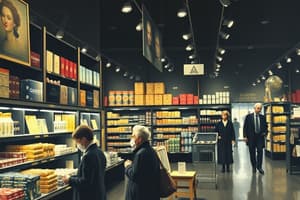Podcast
Questions and Answers
What does 'Playing with the Retail Game' involve?
What does 'Playing with the Retail Game' involve?
Understanding and effectively navigating the complex retail management environment.
What is NOT a function performed by retailers?
What is NOT a function performed by retailers?
- Manufacturing (correct)
- Breaking Bulk
- Holding Inventory
- Assorting
Retail atmospherics refers only to the store layout.
Retail atmospherics refers only to the store layout.
False (B)
What is a Stock Keeping Unit (SKU)?
What is a Stock Keeping Unit (SKU)?
Which of the following is NOT one of the 4 Ps of marketing in retailing?
Which of the following is NOT one of the 4 Ps of marketing in retailing?
What is the role of retailing in the economy?
What is the role of retailing in the economy?
Retailers select a variety of products from different suppliers to meet the needs of their target market, a function called ______.
Retailers select a variety of products from different suppliers to meet the needs of their target market, a function called ______.
What is meant by retail atmospherics?
What is meant by retail atmospherics?
What impact do retailers have on prices and competition?
What impact do retailers have on prices and competition?
Flashcards are hidden until you start studying
Study Notes
Playing with the Retail Game
- Involves strategic decision-making in pricing, inventory management, marketing, customer service, and store layout.
- Retailers must adapt to consumer preferences, market conditions, and technology advancements.
- Success in retail requires understanding market dynamics, consumer behavior, and the competitive landscape.
- Local retailers can compete against larger online stores by offering personalized service, hosting in-store events, and engaging customers through social media.
Economic Value of Retailing
- Retailing creates jobs, supports local economies, and drives consumer spending.
- Acts as a bridge between producers and consumers, facilitating the distribution of goods and services.
- Contributes to economic growth through business revenue, taxes, and employee disposable income.
- Retailers foster innovation and competition, leading to lower prices and improved products for consumers.
- Shopping malls stimulate local economies by providing employment opportunities and attracting visitors.
Functions of a Retailer
- Assorting: Selection of various products from suppliers tailored to target market needs.
- Breaking Bulk: Buying in large quantities and selling in smaller, affordable quantities to consumers.
- Holding Inventory: Storing products to ensure availability when consumer demand arises.
- Providing Services: Enhancing the shopping experience with services like financing and customer support.
- Grocery stores exemplify all functions by offering a diverse range of products, single-item sales, inventory storage, and added services like delivery.
Retail Atmospherics
- Refers to the physical and psychological elements of a retail environment affecting consumer behavior.
- Key components include store layout, lighting, colors, music, scent, and overall ambiance.
- Positive atmospherics encourage customers to extend their shopping time and increase sales.
- Retail environments are designed to reflect brand identity and appeal to target demographics.
- Apple Stores feature minimalist designs and bright lighting to create a tech-forward atmosphere, enhancing brand interaction.
Definition of Stock Keeping Unit (SKU)
- A SKU is a unique identifier for each product in inventory, assisting in inventory management and sales tracking.
- Each SKU relates to specific product details like size, color, and style for efficient monitoring and reordering.
- Retailers managing variations of a product, such as colors and sizes, will have multiple SKUs to track inventory effectively.
Key Marketing Factors in Retailing
- The 4 Ps of marketing:
- Product: The variety of goods/services meeting target market needs.
- Price: Strategies (discounting, premium, dynamic pricing) to remain competitive and attractive.
- Place: Store locations and sales channels that ensure accessibility and convenience for customers.
- Promotion: Marketing strategies aimed at informing and persuading customers regarding products and services.
Studying That Suits You
Use AI to generate personalized quizzes and flashcards to suit your learning preferences.




